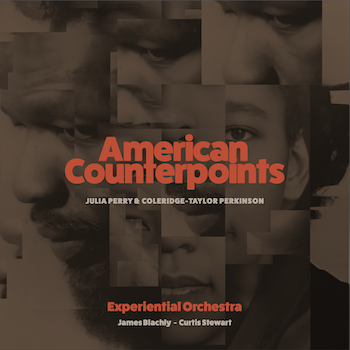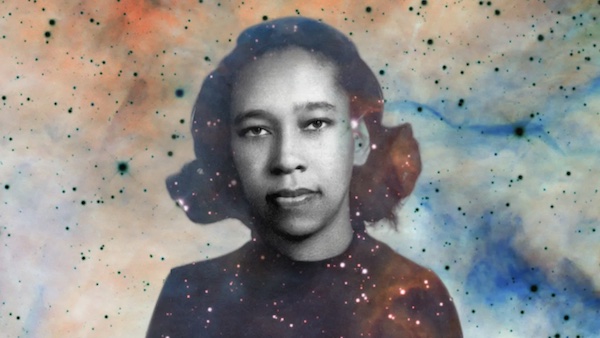Classical Album Review: Experiential Orchestra’s “American Counterpoints” — Fine Music Hiding in Plain Sight
By Jonathan Blumhofer
There’s no question that either the violinist or the orchestra are completely at home with Julia Perry’s larger style or the notes: this is about as confident and secure a first recording as they come.

The recent embrace of music by neglected 20th-century Black composers has been one of the more heartening and revealing trends in classical music these past few decades. At times, it’s turned what little received wisdom there is on this fare on its head: Florence Price, it turns out, was a better composer of short-form pieces than symphonies.
Often, though, the trend has uncovered a lot of fine music that’s been hiding in plain sight, whether that be by Margaret Bonds, William Levi Dawson, or – as the Experiential Orchestra and conductor James Blachley’s new release with violinist Curtis J Stewart asserts – Coleridge-Taylor Perkinson and Julia Perry. Their album, American Counterpoints, juxtaposes these contemporaries with a half-dozen selections that span, roughly, the fifty years ending in 2002.
Perry is by far the less familiar of these two. Born in 1924, she forged a career on both sides of the Atlantic, studying at the Berkshire Music Festival as well as abroad with Nadia Boulanger and Luigi Dallapiccola. Though she won a Guggenheim Fellowship in the mid-‘50s, Perry died in obscurity in 1979.
Fittingly, she’s represented here with a pair of substantial works – the Symphony in One Movement and the Concerto for Violin and Orchestra – plus a couple of shorter ensemble numbers. Between them, they give a fair representation of her sometimes-experimental style.
The biggest item is the Concerto, in its debut recording. Cast in six movements, the score offers a striking play of instrumental colors to go along with seemingly haphazard gestures (the first movement’s cymbal crashes appear to come out of nowhere), echoes of traditional structures (the fifth movement functions, essentially, as a recapitulation of the first), and an uncompromisingly virtuosic solo part.
Stewart navigates the last with no shortage of energy, spirit, and precision. True, he’s not always done favors either by Perry’s scoring, which gets texturally cluttered (the soloist and orchestra find themselves playing in the same register more than a few times), or the recording’s engineering, which embeds the violin too much in the center of the orchestra rather than in the forefront of the mix.
Even so, there’s no question that either the violinist or the orchestra are completely at home with Perry’s larger style or the notes: this is about as confident and secure a first recording as they come.
The same can be said for the Symphony, whose dense textures and vigorous counterpoint emerge strongly. Though the music’s study of stasis and motion proves less a satisfying musical argument than a curious exercise, its dusky, low-string sonority (the Symphony is scored for just violas and basses) proves beguiling.

Composer Julia Amanda Perry (March 25, 1924 – April 24, 1979.) Photo: Bright Shiny Things
More conventional are both the Ye, Who Seek the Truth and the Prelude for Strings. The former unfolds with anthem-like inevitability while the latter paints a lush, languorous portrait.
Perkinson’s contributions consist of the Louisiana Blues Strut and his Sinfonietta No. 1.
The latter, which dates from 1953, is a revelation. Its three movements are thick with counterpoint. The outer pair are vigorous and energetic, reminiscent to some degree of Ernest Bloch. In the center comes a majestic Largo. Throughout, Perkinson’s writing demonstrates a constant sense of invention and rethinking of materials, a technical brilliance that’s mirrored in the taut, well-balanced reading that Blachley draws from his forces.
Stewart brings similarly invigorating panache to his account of the Strut and the closing track, We Who Seek. The last incorporates, in “electro-symphonic…style,” samples from much of what has been heard before, plus the violinist’s spoken meditation on what he styles as “the idea of truth, representation, belonging, and history.”
Easily the album’s singular track, it may or may not add up to the sum of its parts. Either way, the effort lends a personal twist to a recording of repertoire that hardly wants for character – just the opportunity, here compellingly given, to be heard.
Jonathan Blumhofer is a composer and violist who has been active in the greater Boston area since 2004. His music has received numerous awards and been performed by various ensembles, including the American Composers Orchestra, Kiev Philharmonic, Camerata Chicago, Xanthos Ensemble, and Juventas New Music Group. Since receiving his doctorate from Boston University in 2010, Jon has taught at Clark University, Worcester Polytechnic Institute, and online for the University of Phoenix, in addition to writing music criticism for the Worcester Telegram & Gazette.
Tagged: Bright Shiny Things, Coleridge-Taylor Perkinson, Curtis Stewart, Experiential Orchestra, James Blachley
